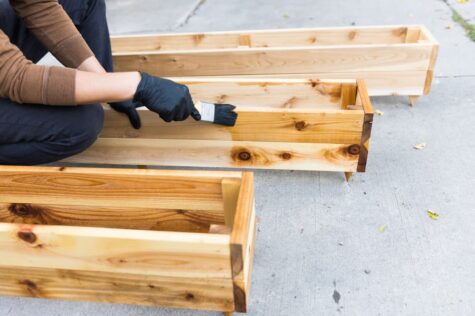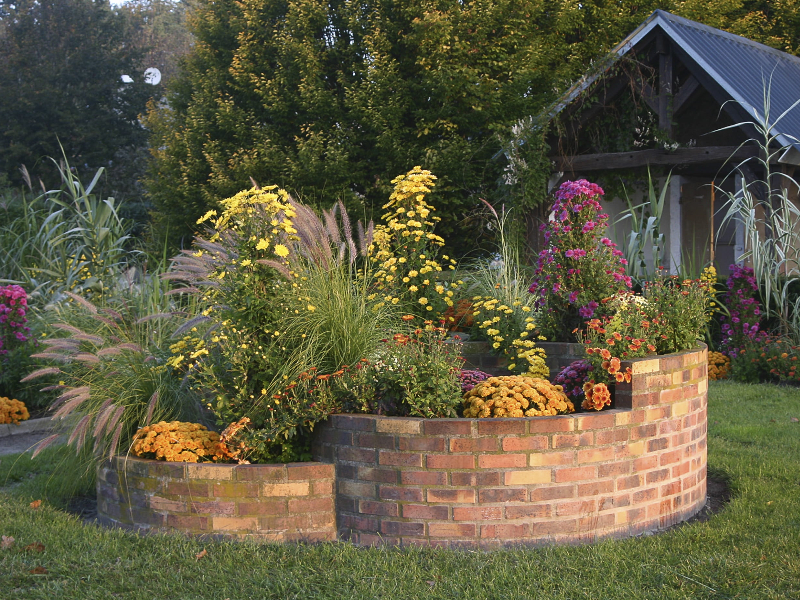Making your own garden furniture can be extremely fun, especially if you love DIY projects. One of the simplest ways to do this is by using cement. Concrete furniture is very durable and can withstand almost all weather conditions for a long time.
The weight of the furniture also makes it impossible for the wind to simply sweep it away. Let’s take a look at how to make concrete garden furniture at home.

Credit: Shutterstock
Step 1: Gather everything you need
Before you can start on your project, you’ll need some supplies. Keep in mind that you might need some extra supplies that aren’t mentioned here, depending on the kind of garden furniture you want to create.
Here is a shortlist for creating a concrete garden bench:
- Cement
- River sand
- 25 mm chipboard screws
- Cheap shutterply or melamine board
- Universal silicone
- Silicone spray, spray and cook or Vaseline
- Masking tape
- Steel rebar or thick wire mesh
- Scrap wood
- Nylon cord or rope
Necessary tools
Once you have all your supplies, you’ll need to make sure you also have the accompanying tools to do the job.
Let’s take a look at what you will need:
- Drill and bits
- Orbital sander with sanding pads
- Large bucket or wheelbarrow for mixing cement
- Spade
- Hammer
- Angle grinder
- Gloves
- Rubber mallet
Now that you have everything ready, it’s time to start your project.
Step 2: Creating the mould
Creating your mould will be the hardest part of this project. If you can get your wood cut by the supplier to the correct lengths, it will save you a lot of time. If not, you’ll need a saw and some elbow grease to get the job done.
Once you have the correct pieces, screw them together. You might need to use the drill to create holes without cracking the wood. Once everything is secure, seal your mould with silicone. The silicone will prevent the cement from leaking out of the mould at any point. You can also use ducktape on top of the silicone to create an extra-secure seal.
Lastly, coat the inside of your mould with either Vaseline, spray and cook or silicone spray to make removing the cement easier later on. These substances will prevent sticking.
Mix the cement
Mixing the cement is quite simple as long as you follow the instructions on the packet. If you have a pre-mix, you won’t need to struggle to add the right amount of river sand, so if you can, get pre-mixed cement. If you can’t, you’ll need to follow the instructions to add the right amount of sand and cement as required.
Another good thing to do before mixing your cement is to measure your water. Try to make sure all your cement is wet, but not completely runny. The consistency should be something like yoghurt. Getting the right consistency is key for a well-formed bench. The consistency of your cement will allow it to fill all corners without running out.
Use gloves to mix the cement thoroughly since the rough texture will damage your hands and nails.

Credit: Shutterstock
Another better alternative is to mix the cement with a shovel.
Step 3: Place the rebar poles or mesh
Fill the bottom of your mould with cement until it’s about halfway full. Make sure to hit the side of the mould frequently between batches with the rubber mallet to remove any air bubbles in the mix.
Get your rebar ready. If your rebar is already the correct length, you won’t need to cut the rods. If not, however, use the angle grinder to cut them into the correct lengths.
Once done, you can push the rods or mesh into the cement and fill up the rest of the mould. Make sure to seal the piece between the legs to prevent your cement from spilling. You can use silicone and masking tape along with wood to achieve this.

Use steel rods or a mesh to reinforce concrete. Credit: Shutterstock
Place the rest of your rebar rods vertical to the ground in the part of the mould that will create the legs of your bench. Once done, fill up the whole structure with cement. Make sure all rebar rods are covered completely by the cement.
Once everything is done, hit the outside of the mould with the rubber mallet one last time. This will ensure all the air bubbles trapped in the cement gets filled up and the air released.
Step 4: Let it dry
Now the waiting begins. Your mould will need to dry for a minimum of 21 days. Make sure to cover any open ends with cling wrap to prevent water from evaporating too quickly. Your cement might crack if it dries too quickly.
Once the 21 days are up, you can remove the bench from its mould.
Do this by taking out all the screws and separating the mould from the cement. If you’ve pregreased it with Vaseline or something similar, it should come away fairly easily. Once out of the mould, you can sand down any sharp edges and paint the concrete if you so desire.

Sand away any sharp edges. Credit: Shutterstock
If you made the legs and seat in separate moulds, you can now assemble the bench. Use some cement to seal the legs to the seating area. Only a thin layer is necessary and you can remove any cement that leaks out.
Make sure the legs are level before you let them dry in their correct positions. A few days after the assembly, you can move the bench to its forever home.
Keep in mind that this structure will weigh around 250kg (551 pounds) or more so you’ll need some help to move it. The ropes come in very handy for moving the structure.

Concrete furniture certainly won’t get damaged by the wind! Image credit: Houzz
FAQs
Does a concrete bench need a rebar?
Yes, concrete on its own isn’t strong enough to support itself along with the extra weight of the object or person on it.
Do concrete countertops crack?
Yes, concrete countertops tend to crack. Some cracks can be prevented, but most cracks that form on countertops is due to the natural sinkage of the concrete. Fortunately, they are non-structural and won’t normally compromise the countertop as a whole.
How thin can I make a concrete tabletop?
The minimum for a strong concrete countertop is 3.18 cm (1 ¼”) thick. The standard thickness, however, is 3.81 cm (1 ½”) thick.
Read more: How to make rustic garden furniture

Save this pin for later






